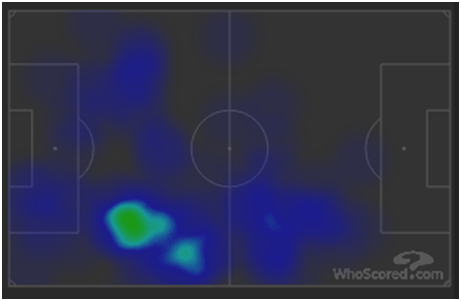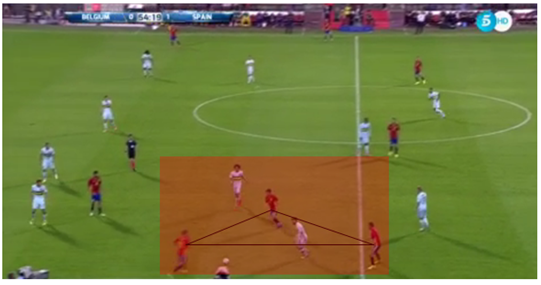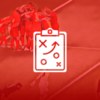Miles Olusina writes a detailed tactical analysis about the international friendly that ended Belgium 0-2 Spain.
Two giants of the European international game faced off in this friendly, with both sporting new faces in the dugout. For Belgium, it marked the debut of new duo Roberto Martinez and Thierry Henry while for Spain, surprise appointment Julen Lopetegui was appearing for the first time as Spain boss. With nothing at stake for either side, many believed that this would have the feel of a practice match. However, both teams were eager to bounce back after disappointing Euro 2016 campaigns and build some much needed confidence heading into the World Cup qualifiers.
The game was played with a great intensity and made for quite a fascinating one from a tactical perspective. Belgium did very well to hold their own against the former World and European champions; although they created very little in terms of chances, they were well structured defensively for most of the first half until Spain wore them down with incessant ball circulation causing them to falter as the game progressed. Spain proved too much for the Red Devils in the end with Silva particularly impressive in his role as an inverted winger. Spain looked very much like their former selves and maintained control for most of the game. One can only hope that we see this Spain on a regular basis once again.
Belgium 0-2 Spain
Line Ups:

Made using Tactical Pad
Belgium (4-2-3-1): 1. Courtois // 15 Meunier, 4. Vertonghen, 2. Alderweireld, 21. J. Lukaku // 6. Witsel, 4. Nainggolan // 8. Carrasco, 7. De Bruyne, 10. Hazard // 17. Origi
Spain (4-3-3): 1. De Gea // 20. Carvajal, 15. Ramos, 3. Pique, 18. Jordi Alba // 5. Busquets, 10. Thiago, 8. Koke // 11. Vitolo, 7. Morata, 21. Silva
Substitutions: 46’ Dembele (Nainggolan), 67’ R. Lukaku (Origi), 77’ Mirallas (Carrasco), 87’ Defour (De Bruyne) // 27’ Diego Costa (Morata), 59’ Bartra (Pique), 59’ Azpilicueta (Jordi Alba), 75’ Saul (Vitolo), 75’ Lucas Vazquez (Silva), 85’ Sergi Roberto (Carvajal)
Goals: 34’ Silva, 62’ Silva
Ball-oriented Belgium disrupt Spain but begin to fade
The Belgians looked to set the tone early on in the game, applying quite aggressive pressure in the 1st phase. Unlike most teams when up against Spain, Belgium opted against retaining compactness and halting central progression into the 6 space. Instead they chose to deploy a high line with De Bruyne and Origi leading the pressure, who were not afraid to apply on the centre backs.

Belgium shape in 1st phase of pressure
The midfield has been staggered with the team looking a more solid unit and Spain now less able to play between the lines should they evade the 1st wave of pressure. Nainggolan and Carrasco appeared to have maintained a close distance to the two Spain 8s Thiago and Koke, blocking both their passing lanes with cover shadows. Ramos is in possession and has no option but to play it wide to Alba or backwards to De Gea. Either option is a trigger for Belgium to push further forward and apply more pressure to the Spain centre-back.
De Bruyne chooses to vacate his 10 position and runs directly towards Ramos who as well as being short for viable passing options now has a limited time to make a decision due to the onrushing De Bruyne. Ramos hurries and passes the ball back to De Gea and Belgium have now gained ground and forced the Spaniards into their own half even more.
What was surprising though was his decision to completely ignore the potential danger posed by Busquets in the Spain 6 space. Had he not positioned himself so intelligently, it could have resulted in Busquets receiving the ball in space and drawing Witsel towards him who would have no choice but to leave his position in front of the back 4. This would in turn create more room for Koke in the half-space, who could have easily played a penetrative ball through to Alvaro Morata. De Bruyne did well by cover shadowing Busquets, thus not allowing Ramos to play any vertical passes into the centre.
With Belgium doing well to stop Spain from constructing play centrally, many would have assumed that Spain would have been vulnerable to ceding possession in areas dangerously close to their goal. Despite having very skilled ball players in the back 4, Spain would ultimately have been forced to play into the full backs in the wide areas, whose fields of view were severely limited due to the lack of space in these zones. In addition, they would have been much more susceptible to pressure and also being caught in possession as their zones in relation to the back 4 would have been left wide open; a potentially dangerous situation especially when faced with two wingers of the calibre of Hazard and Carrasco.
Spain managed this cleverly though, and proved that is very possible to construct possession through the full-back zones in the 1st phase of attack, contrary to popular belief. The key to their ability to play through these difficult scenarios was the escape pass option provided by Thiago and Koke and on occasion, Busquets.

Both Thiago and Vitolo have offered pressure relief to Carvajal as he receives the ball in the wide zone. Vitolo chose to drop deep from his advanced position on the right wing and Thiago shuffled into the half-space. An overload of 3v2 has been created as well as a triangle to allow Spain to play around Nainggolan and Jordan Lukaku with ease. Thiago’s movement has had the knock on effect of attracting Nainggolan and moving him away from his 6 space, which has aided Alvaro Morata up front. Hazard’s decision not to assist his teammates here has allowed Spain much more dominance in this scenario and led to his side being less organised.
Normally when most teams play through the full-back in the 1st phase, they often come unstuck due to their inability to form adequate structures which allow for an overload or at the very least an escape pass. He typically receives the ball in an isolated position and when crowded out by opposition players, gives possession away cheaply.

As predicted though, this intense pressure was unsustainable against a side like Spain and eventually Belgium not only applied their press with less vigour and frequency but also began to defend with less compactness. Though they did remain compact for much of the match it became more difficult to do so the longer the game went on as a result of Spain’s ball circulation and the movement of their midfielders. They were constantly forced to move from their position to prohibit the opposing midfield players from obtaining the ball in dangerous areas and creating overloads.
This is exactly what is being witnessed in this image with Silva receiving the ball in the left half-space. De Bruyne naturally senses the potential danger of allowing David Silva time in possession and is quick to apply pressure. The downside to this though, is that Busquets is now left completely open in the centre. Should he receive the ball, it would spell trouble for Belgium who are probably well aware of the possible damage caused by giving Busquets so much space in possession of the ball.
The space between the lines between the defence and midfield has also increased as a result of the two 6s being on the similar lines. There now appears to be a disconnect between the two lines and an abundance of space which could be exploited by one of the forwards if they drop into that area.
Belgium positional structure severely inhibits attack
Roberto Martinez’s side put in a competent performance defensively, something which could be considered very commendable considering he was without his best centre-back in Vincent Kompany. The same could not be said about Belgium in the attacking phase though. Spain defended well and denied them space in the final third, however, that does not change the fact that Belgium looked rather poor in attacking situations.
Key players such as Kevin De Bruyne often went missing and did very little to galvanise their side. The team’s structure with the ball did not help them at all with multiple players on the same line and a lack of presence in central areas and within Spain’s defensive block. The midfielders were far too static which resulted in an inability to effectively circulate ball and move their opponents away from their defensive block.

Belgium poor structure in possession
Jordan Lukaku is in possession here and does not have many options to allow play to progress. His best option is Witsel but he is isolated and will have no vertical passing opportunities should he be given the ball as well. We can also see that Hazard is having his passing lane blocked by Vitolo and is therefore rendered ineffective in this phase. The lack of occupation of the space between the lines is also detrimental. With such a large amount of space that could be exploited, it is puzzling that De Bruyne chose not to position himself there. This would almost certainly have disrupted the Spanish defensive structure and allowed him time to run at the defence or possibly pick out a pass.
The three midfielders, Hazard, Nainggolan and De Bruyne are all on virtually the same line also. None of them would be in a position to play a significant vertical pass if receive the ball. A possible solution would have been for Witsel to move into the half-space which would allow him to play the ball into Hazard. Hazard, now in possession, could either play it into Nainggolan or drive into the centre and take advantage of his wonderful balance and dribbling ability. Naturally, Busquets and Thiago would be compelled to apply pressure on him which would open up the centre completely for De Bruyne.

Another example of the Belgium players failing to position themselves adequately can be seen here with Nainggolan in possession. The Belgium full backs Lukaku and Meunier were smart in pushing forward; resulting in the Spanish wingers being forced back severely and leaving the half-spaces wide open. One of the multiple problems with their shape in this image though, is the over-compactness of the 3 Belgium players in central midfield. Their options are now severely limited with so much space in midfield left unoccupied, Spain’s midfield are not being dragged out position at all due to all three midfielders remaining in more or less the same position.
As well as this, the half-spaces are not being exploited by the wingers in the way that they could be. With the full backs providing the width, the wide men would be expected to move into the half-spaces. Instead they remain central and in addition, are in the cover shadows of the Spanish midfielders. As a result of the poor positioning, the team shape is around the defensive block instead of between the lines. It leads to a failure to penetrate the opposition shape and an inability to gain any control of the centre. This has ramifications for the defensive transition phase as the centre is now left exposed which could lead to them being vulnerable if they lose the ball and Spain counter with pace.
Silva instrumental in helping Spain control centre
With 2 goals on the night, there was absolutely no doubt as to who the best player was in this game. Silva was a constant thorn in the Belgian side, however added much more to the game than just goals. He took up a position on the left side of midfield but very rarely hugged the touchline, instead he predominantly occupying the half-spaces, allowing for greater connectivity between the centre and the wide areas and creating space in the centre for Thiago and Koke in centre midfield.

David Silva heatmap via WhoScored
As you can see from the heatmap, he spent most of his time in the half-space and created constant problems for the full-back as he constantly roamed to create overloads and rotated positions with Koke. At times when Belgium were proving difficult to penetrate Koke would drift out wide to the left hand side, allowing Silva to move into the centre. Meunier at right back would often have some apprehension in following him and thus Silva would often be afforded plenty of space and time on the ball.

Silva in half-space, greater connections for Spain
Jordi Alba is in possession and has a number of potential passing options. The spacing in this Spain structure is optimal and all the columns are being occupied sufficiently. Silva and Costa are key in this scenario here, positioning themselves right in between the lines, in the middle of the Belgium defensive block. If either receive the ball, Belgium midfielders will be sure to put pressure on the ball. However, Silva’s intelligence in possession and press resistance due to his balance and ball control will make it difficult for him to lose possession. The fact that he has a plethora of options accentuates this and allows him to have a variety of combinations and presents a real danger for the opposition.

The understanding between him and Jordi Alba was exceptional in this game also. They exhibited key aspects of Juego de Posición wonderfully, never occupying the same line, which proved effective in their ability to form structures on the wings. The two of them are pictured above with Koke on the left wing. When Alba is on the wing Silva was also sure to occupy the half-space and vice versa. Koke would do the same and as seen in the image, it resulted in a triangle being formed and an overload being created out wide. Costa’s positioning is noteworthy also. He makes a movement around the CB-RB zone so as to occupy Meunier in order to ensure that he does not move forward to counter the overload created by Spain.
Conclusion
All in all, it was a dominant showing from Lopetegui’s men. With the possible exception of Iniesta, this was more or less a full strength squad. With the new generation of young players coming through and a new man at the helm, this was exactly the start they were looking for. If they can put in more performances like this against top sides, they are sure to be contenders for the World Cup in Russia and put the dismal last few years behind them.
Belgium should not feel too downhearted by this defeat. A game against Spain is always a challenging one and their task was made all the more difficult due to the absence of Kompany and Romelu Lukaku in the first half. However, their performances against the top sides must improve if they want to be considered one of the elites of international football. With their golden generation soon to reach their peak, it is imperative that they go from simply knocking on the door to mixing it with the best. Admittedly with the side still young, they have time on their hands to gel as a unit but must surely be looking to go beyond the quarter finals in the next World Cup if they truly want to make their mark.
Read all our other Tactical Analyses here.
- Scout Report: Marcus Thuram | Gladbach’s attacking sensation - July 17, 2020
- Tactical Philosophy: Paulo Fonseca - May 28, 2020
- Maurizio Sarri at Chelsea: Tactical Approach & Key Players - September 5, 2018























































